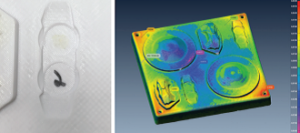
 One of the most well-known companies in the 3D printing industry, Stratasys, can call itself a leader for good reason – the company definitely knows what it’s talking about in terms of the latest additive manufacturing innovations, many of which Stratasys itself introduces.
One of the most well-known companies in the 3D printing industry, Stratasys, can call itself a leader for good reason – the company definitely knows what it’s talking about in terms of the latest additive manufacturing innovations, many of which Stratasys itself introduces.
Stratasys wants to make sure that it is sharing its expertise with the rest of the world, and published a brand new whitepaper on 3DPrint.com earlier this week.
This new whitepaper, titled “Take Advantage of the Multiple Benefits FDM Thermoform Tooling Offers,” is an FDM thermoforming design guide, and takes an in-depth look at using FDM 3D printing technology to manufacture thermoform tooling.
The description for the whitepaper reads, “Fast, cost‐efficient tool creation makes low‐volume production economical and quick customization easily viable, without sacrificing design complexity. Learn how to create FDM thermoform tooling with our comprehensive Design Guide.”

An ULTEM 9085 resin tool (left) is recommended for materials being formed over 360 °F (182 °C), such as Kydex.
Thermoforming is a manufacturing process that uses heat and pressure to bring a thermoplastic sheet or film to a pliable forming temperature. The sheet is clamped and heated to what’s known as the sag point, then formed into a specific shape inside a mold, and finally trimmed to create a usable product. The temperature needs to be high enough that the sheet can be stretched onto, or into, a mold, before it’s cooled to the final shape.
Traditionally, tooling for thermoforming has been made from materials like cast aluminum, machined aluminum billet, and even wood. However, these methods are expensive and can take a long time, which is why many thermoform part manufacturers are looking for better solutions to low- to moderate-quantity production runs. That’s where Stratasys’ FDM technology comes into play.
The technical design guide in the new whitepaper describes the procedures and techniques for designing, processing, manufacturing, and post-processing thermoform tooling using FDM 3D printing. Stratasys engineers investigated if it was feasible to lower lead times, material waste, and tooling costs by 3D printing thermoforming tools, and completed a series of lifecycle testing with ABS and Kydex thermoforming materials formed over 3D printed tools.
- PC tool being raised into the heated ABS sheet (L) and forming the ABS part over the PC mold (R).
- The surface of the PC tool after 6 Kydex forming cycles (L)and a scan comparison of the tool (R) after 6 cycles to the base scan at a scale of ±0.050 inch (1.27 mm).
When the engineers paired these materials with 3D printing ones, such as polycarbonate, ABS, and ULTEM 9085 resin, they gained a more clear understanding of, as the whitepaper puts it, “the design criteria needed to meet specific application needs from various industries such as aerospace and automotive.”
 Stratasys also assessed the six main drivers of AM technology to see just how well it can improve thermoform tooling:
Stratasys also assessed the six main drivers of AM technology to see just how well it can improve thermoform tooling:
- Economic Low-Volume Production
- Life Cycle Sustainability
- Increased Part Functionality
- Supply Chain Realignment
- Cost Effective Product Customization
- Increased Product Complexity
The new Stratasys whitepaper concludes that FDM thermoform tooling is a simpler, less expensive way to produce low-volume thermoformed parts. If you are interested in learning more about about how Stratasys’ FDM technology can enable more design freedom and other benefits in the thermoforming industry, you can download the whitepaper for free here.
Discuss this and other 3D printing topics at 3DPrintBoard.com or share your thoughts in the Facebook comments below.
[Images: Stratasys]
Subscribe to Our Email Newsletter
Stay up-to-date on all the latest news from the 3D printing industry and receive information and offers from third party vendors.
You May Also Like
NSF Awards Kentucky $1M for Advanced Manufacturing
The National Science Foundation has awarded a $1 million grant to the University of Louisville for the Advancing Manufacturing and Building Construction Technologies (NSF AMT) project. This initiative is part...
3D Printing News Briefs, May 11, 2024: 3D Printed Stent, Tower, Sculptures, & More
We’re starting off with medical research in today’s 3D Printing News Briefs, as researchers in Korea used CT images and 3D printing to fabricate an educational simulator for a mastoidectomy....
3D Printing Unpeeled: Wind Turbines, Probiotics and Lenses
TPI Composites, ORNL and Ingersoll Rand are working to make wind turbine tooling segments that can be 18.3 meters long. These elements also include resistive wires that help keep the...
Tethon 3D Releases Cost-effective Bioprinter
Tethon 3D, known for its ceramic-loaded DLP materials, custom resins, and DLP 3D printers, has recently released a bioprinter. Vat polymerization printers like DLP systems have been widely used by...



































